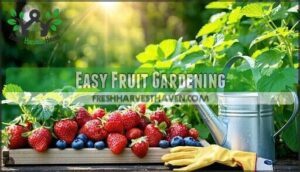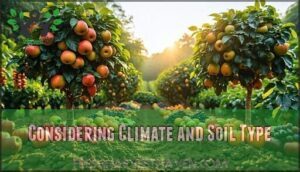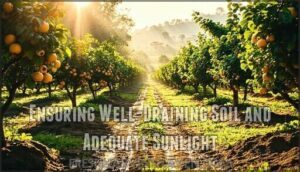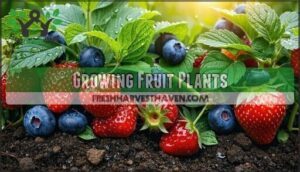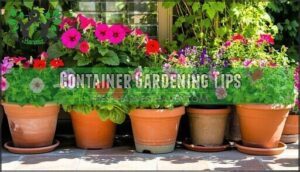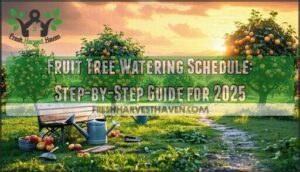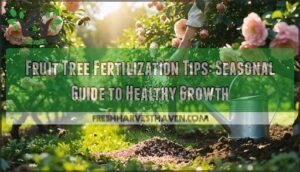This site is supported by our readers. We may earn a commission, at no cost to you, if you purchase through links.
 Easy fruit gardening for beginners starts with choosing the right plants for your space and climate.
Easy fruit gardening for beginners starts with choosing the right plants for your space and climate.
Strawberries, blueberries, and dwarf fruit trees are perfect starter options since they’re forgiving and produce fruit quickly.
You’ll need well-draining soil with at least six hours of sunlight daily.
Container gardening works great if you’re short on space or dealing with poor soil.
Start small with one or two plants, water consistently but don’t overdo it, and add organic compost to keep your plants happy.
Most beginners make the mistake of overwatering, so check soil moisture first.
The secret lies in understanding each plant’s specific needs.
Table Of Contents
- Key Takeaways
- Easy Fruit Gardening
- Choosing Fruit Plants
- Preparing Garden Soil
- Growing Fruit Plants
- Container Gardening Tips
- Frequently Asked Questions (FAQs)
- What fruits are easy to grow?
- Can you grow fruit in a home garden?
- How do I choose easy fruits to grow at home?
- Which fruit is best for a first time gardener?
- Are fruits and vegetables easy to grow?
- What fruits can you grow in a small space?
- What fruit is the easiest to grow for beginners?
- What is the easiest fruit to grow inside?
- What is the most common mistake of first time gardeners?
- What is the easiest fruit to grow in a garden?
- Conclusion
Key Takeaways
- Start with beginner-friendly plants – Choose strawberries, blueberries, and dwarf fruit trees since they’re forgiving, produce fruit quickly, and don’t require years to establish like full-sized trees.
- Focus on soil and sunlight basics – You’ll need well-draining soil with 6+ hours of daily sunlight, and container gardening works perfectly if you’re dealing with poor soil or limited space.
- Avoid overwatering mistakes – Check soil moisture before watering since most beginners kill plants by watering too frequently rather than too little.
- Match plants to your conditions – Test your soil pH (most fruits prefer 6.0-7.0), consider your climate zone, and choose varieties that’ll actually thrive in your specific growing environment.
Easy Fruit Gardening
You can start growing your own fresh fruit with just a few simple plants and basic gardening knowledge.
Fresh homegrown fruit tastes better, costs less than store-bought options, and gives you complete control over how your food is grown, with the added benefit that it tastes better.
Benefits of Growing Own Fruit
Through fruit gardening, you’ll discover freshness guarantee that store-bought produce can’t match.
Growing beginner-friendly fruits like strawberries offers pesticide reduction while providing variety access to unique cultivars.
This family activity enhances flavor beyond commercial options, delivering superior fruit nutrition, making beginnerfriendly fruits perfect for beginner gardening enthusiasts seeking homegrown satisfaction.
Health Benefits of Fresh Fruit
When you grow your own fruit, you’re investing in your health with every bite.
Homegrown produce delivers peak vitamins and minerals your body craves for ideal function.
Here are four key health benefits of fresh fruit gardening:
- Disease Prevention – Antioxidants in fresh berries and citrus strengthen your immune system naturally
- Gut Health – High fiber content from apples and pears supports healthy digestion daily
- Weight Management – Natural sugars satisfy cravings while keeping calories in check
- Mental Wellbeing – Gardening reduces stress while providing nutritious rewards
Easy fruits like strawberries and blueberries make beginner gardening simple while boosting fruit nutrition intake.
Cost-Effective and Environmentally Friendly
Most gardeners spend hundreds yearly on store-bought fruit, but your backyard offers financial freedom.
Your backyard transforms grocery bills into garden gold with every homegrown harvest.
Growing your own cuts grocery bills dramatically while supporting local varieties that thrive naturally.
Organic fertilizers from kitchen scraps replace expensive chemicals, and water conservation through mulching reduces utility costs.
Pest control using companion planting eliminates pesticide purchases.
Propagation methods like runner division multiply plants free.
This easy fruit gardening approach makes organic gardening accessible for gardening for beginners seeking low maintenance fruit with smart fruit plant care.
Choosing Fruit Plants
Selecting the right fruit plants sets the foundation for your gardening success, so you’ll want to match your choices to your specific growing conditions and space constraints.
The key is understanding your local climate, soil type, and available garden space before making any plant purchases, which is crucial for gardening success.
Considering Climate and Soil Type
Climate suitability determines your gardening success before you plant anything.
Test your soil pH first—most fruits prefer 6.0-7.0 range.
Local varieties adapted to your area handle weather extremes better than exotic options.
Check for microclimates around your property that create warmer or cooler spots.
Drainage importance can’t be overstated since waterlogged roots kill plants quickly.
Easy fruit gardening for beginners starts with matching soil requirements to climate suitability and choosing appropriate fruit varieties, focusing on complete concepts.
Selecting Fruit Plants for Small Spaces
Small spaces don’t limit your fruit-growing dreams. Dwarf varieties make full-sized harvests possible in compact areas. Container options let you move plants for ideal sunlight, while vertical gardening maximizes growing space upward.
**Compact spaces, full-sized harvests—your patio can produce abundant fresh fruit.
Espalier techniques train trees flat against walls, perfect for patio fruit production. Selecting containers with proper drainage is key for healthy growth.
These space-saving methods work well for beginners wanting fresh fruit without large yards.
- Dwarf apple trees – produce full-sized apples in 6-8 feet
- Columnar fruit trees – grow tall and narrow, perfect for tight spots
- Berry bushes in containers – blueberries and raspberries thrive in pots
- Espaliered pears – trained flat against fences or walls
- Compact citrus trees – lemons and limes perfect for patios
Factors to Consider When Selecting Fruit Plants
Before choosing fruit plants, consider several key factors that’ll determine your success. Pollination needs matter most—some fruits need partner plants while others self-pollinate. Plant size affects spacing; dwarf varieties work great in containers.
Check maintenance level requirements since beginner fruit trees like figs need minimal care compared to apples. Many resources are available to help you find the best starter options. Disease resistance saves headaches later. Fruit yield varies by variety and growing conditions.
Match plants to your climate and soil type—blueberries thrive in acidic soil while citrus prefers neutral pH.
Easy fruits like strawberries and beginner fruit plants such as blackberries offer quick rewards with minimal fuss. Smart fruit plant selection means choosing varieties that match your experience level and garden conditions.
Preparing Garden Soil
Before you plant your first fruit bush, you’ll need to create the perfect foundation for healthy growth.
Proper soil preparation sets the stage for years of delicious harvests, transforming your backyard into a productive fruit garden, with healthy growth being the key to success.
Ensuring Well-Draining Soil and Adequate Sunlight
Your fruit trees need proper soil drainage and adequate sunlight exposure to thrive.
Test your soil composition first—most fruit varieties require well-draining soil with a pH between 6.0-7.0. Implement drainage techniques like raised beds if water pools after rain.
For light requirements, guarantee six hours of direct sunlight daily through strategic plant placement.
Addressing poor soil conditions is vital for fruit tree health.
These essential gardening tips help beginners create ideal growing conditions for healthy fruit production.
Using Organic Matter and Mulch
Mixing organic matter into your soil transforms it from ordinary dirt into a plant powerhouse. You’ll boost soil fertility while creating the perfect growing environment for easy fruits beginners love.
Here’s how to prepare your soil effectively:
- Add 2-4 inches of compost – Work it into the top 8 inches of soil
- Apply mulch layers – Spread 2-4 inches around plants, avoiding stems
- Choose proper materials – Use well-decomposed compost, straw, or wood chips
- Maintain annually – Refresh organic matter and mulch as needed
This soil preparation delivers moisture conservation, weed suppression, and temperature regulation. Before planting, remember to test your soil, as the ideal pH range is essential for nutrient availability. The mulch improves air circulation while organic matter feeds beneficial microbes that support your fruit plants’ growth.
Providing Support for Taller Plants
After enriching your soil with organic matter and mulch, you’ll need to support taller fruit plants.
Proper support prevents breakage and promotes healthy growth.
- Staking Methods: Use sturdy stakes for young fruit trees, securing them with soft ties that won’t damage bark
- Trellis Selection: Install strong trellises for berry bushes and vines, choosing materials that can handle fruit weight
- Vine Training: Guide climbing plants along support structures using gentle ties, allowing room for growth
Espalier techniques work well for small spaces, training fruit trees against walls or fences.
Remember that proper fruit plant support saves you from dealing with broken branches later.
Growing Fruit Plants
Once you’ve prepared your soil, it’s time to focus on the ongoing care that keeps your fruit plants healthy and productive.
Consistent watering, proper feeding, and regular maintenance will help your plants thrive and reward you with abundant harvests season after season.
Watering and Feeding Fruit Plants
Watering plants well sets the foundation for healthy fruit production.
Most fruit plants need about one inch of water weekly through consistent watering techniques.
Watering frequency depends on soil type and weather conditions.
Organic amendments like compost provide slow-release nutrients, while garden fertilizers address specific nutrient deficiencies.
Monitor soil pH levels regularly for ideal fruit plant care.
| Watering Method | Best For | Frequency |
|---|---|---|
| Soaker hose | Established plants | 2-3 times weekly |
| Drip irrigation | Container fruits | Daily in summer |
| Hand watering | Small gardens | As soil dries |
| Rainwater collection | All fruit types | Supplement natural rain |
| Deep watering | Tree fruits | Weekly, long sessions |
Pruning and Training Fruit Plants
Regular pruning keeps your fruit plants healthy and productive.
Use clean, sharp tools to remove dead branches and shape growth patterns.
Raspberries need annual cane removal after fruiting.
Training Methods like trellising improve airflow and sunlight exposure.
These Pruning Techniques boost Fruit Yield while maintaining Plant Health through proper fruit garden maintenance and berry plant care.
Protecting Fruit Plants From Pests and Diseases
Once you’ve shaped your fruit trees and berry bushes through pruning, keeping them healthy means staying alert to pest identification and disease prevention.
Organic solutions like neem oil work great for natural control, while chemical controls should be your backup plan.
Practice integrated management by removing fallen fruit, encouraging beneficial insects with nearby flowers, and rotating crops to break pest cycles.
Good garden hygiene prevents most problems before they start in fruit gardening.
Companion planting with basil and marigolds offers natural pest repellents for your fruit garden.
Container Gardening Tips
Container gardening opens up fruit growing possibilities even when you don’t have yard space or suitable soil conditions.
You can grow strawberries, dwarf fruit trees, and berry bushes in pots on patios, balconies, or any sunny spot with proper containers and care.
Benefits of Container Gardening
Container gardening opens doors for beginners who want fresh fruit without yard space.
You can grow easygrow fruits anywhere with proper containers and care.
- Space Optimization: Transform balconies, patios, or windowsills into productive fruit gardens using vertical growing techniques
- Portability Advantages: Move containers to follow sunlight patterns or bring plants indoors during harsh weather conditions
- Pest Control: Monitor and protect your plants more easily than ground-planted varieties, reducing common garden problems
Urban gardening becomes manageable when you control soil management completely.
Container fruit gardening delivers early harvests while fitting perfectly into small living spaces.
Choosing The Right Containers for Fruit Plants
Selecting the right containers for your fruit cultivation adventure requires careful consideration of several factors. Container size matters most – choose pots holding 12-20 gallons with 18-inch depth for healthy root development.
Drainage importance can’t be overstated since waterlogged roots spell disaster for your plants.
| Container Type | Benefits | Drawbacks |
|---|---|---|
| Plastic | Lightweight, retains moisture | May overheat roots |
| Terracotta | Breathable, attractive | Dries quickly, heavy |
| Wood | Natural insulation | Requires treatment |
Material types each offer unique advantages. Plastic containers stay lightweight and portable, while terracotta provides excellent breathability. Wooden planters offer natural aesthetics but need weatherproofing.
Many gardeners find plastic pots are ideal for maintaining moisture. Portability options become important for container gardening beginners growing containerfriendly fruits.
Rolling casters help you chase sunlight or protect fruit trees during harsh weather. Aesthetic appeal shouldn’t be forgotten – beautiful containers enhance your garden’s visual impact while supporting healthy plant growth.
Caring for Fruit Plants in Containers
Your container soil needs daily attention since pots dry faster than garden beds. Check moisture by sticking your finger one inch deep—if it’s dry, water thoroughly until drainage appears.
Feed containerfriendly fruits monthly with liquid fertilizer during growing season. Verify proper drainage prevents root rot in your easytogrow fruits.
Move containers indoors during harsh weather for overwintering plants. Regular pruning containers keeps fruit trees for beginners manageable.
Watch for pest clusters on patio setups—they spread quickly in confined spaces. Proper fruit container gardening creates thriving harvests with consistent watering needs and fertilizing schedule attention.
For ideal growth, verify containers have adequate drainage holes.
Frequently Asked Questions (FAQs)
What fruits are easy to grow?
You’ll love growing strawberries, raspberries, and blackberries – they’re hardy, produce fruit quickly, and thrive in containers or gardens with minimal care needed.
Can you grow fruit in a home garden?
Absolutely, you’re sitting on a goldmine of possibilities! Growing fruit in your home garden is definitely doable. You’ll need well-draining soil, full sunlight, and consistent watering for success.
How do I choose easy fruits to grow at home?
Choose fruits that match your climate and require minimal care. Start with strawberries, raspberries, or blackberries—they’re hardy, productive, and don’t need years to establish like fruit trees do.
Which fruit is best for a first time gardener?
Like teaching a child to walk, start with strawberries—they’re forgiving, produce fruit quickly, and thrive in containers with minimal care, making success almost guaranteed for beginners.
Are fruits and vegetables easy to grow?
Fruits are generally easier than vegetables since they’re perennials requiring less annual replanting. However, both need proper soil, sunlight, and consistent watering to thrive successfully.
What fruits can you grow in a small space?
Small gardens bloom like hidden treasures when you plant strawberries in containers, dwarf fruit trees, raspberries on trellises, blueberries in pots, and currants in tight corners—all thriving beautifully.
What fruit is the easiest to grow for beginners?
Strawberries top the beginner-friendly list because they’re hardy, produce fruit quickly, and thrive in containers with minimal care. You’ll harvest berries within months of planting them.
What is the easiest fruit to grow inside?
You’ll find strawberries are your best bet for indoor growing. They adapt perfectly to containers, need minimal space, and thrive in sunny windowsills with consistent watering.
What is the most common mistake of first time gardeners?
Like putting the cart before the horse, you might skip soil preparation and jump straight to planting.
If you don’t test and amend your soil first, your plants could struggle, leading to weak growth and disappointing harvests, which can result from neglecting this crucial step, emphasizing the importance of soil preparation.
What is the easiest fruit to grow in a garden?
Berries are your best bet for beginner success. Strawberries top the list—they’re practically foolproof, produce fruit quickly, and thrive in containers or garden beds with minimal fuss.
Conclusion
Success awaits you in easy fruit gardening for beginners once you’ve mastered these fundamentals.
You’ll discover that consistent watering, proper soil preparation, and choosing climate-appropriate plants create the foundation for abundant harvests.
Remember, patience pays off—your first strawberries or blueberries will taste sweeter knowing you grew them yourself.
Start small, stay consistent, and watch your confidence grow alongside your plants.
Soon, you’ll be enjoying fresh, homegrown fruit straight from your garden.
- https://www.gardeningknowhow.com/edible/fruits/fegen/fruits-for-beginners.htm
- https://www.gardentech.com/blog/gardening-and-healthy-living/8-easy-to-grow-fruits-and-veggies
- https://www.thespruce.com/tips-for-beginner-gardeners-5221361
- https://www.kellogggarden.com/blog/gardening/how-to-start-a-simple-spring-vegetable-garden-box/
- https://www.linkedin.com/in/nancy-trautz-awot-b16b8559

